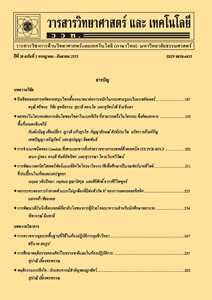การประเมินความเสี่ยงจุลินทรีย์เชิงปริมาณของ Total Coliform และ Fecal Coliform จากตู้กดน้ำดื่มในมหาวิทยาลัยธรรมศาสตร์ ศูนย์รังสิต
Main Article Content
Abstract
This study investigated the quantitative risk assessment of total coliform and fecal coliform in drinking water from drinking water dispenser in Thammasat University, Rangsit Centre as a biological risk assessment. The risk assessment method recommended by The Codex Alimentarius Commission (CAC) was used in this study. The number of microorganisms contaminated in drinking water dispenser was conducted in Thammasat University, Rangsit Centre. The first area (1st area) was cafeteria and lecture buildings and the second area (2nd area) was dormitories. The results were analyzed by a multiple tube fermentation technique and calculated based on the mathematical equations. The results showed that water from the 1st area had a higher of probability of exposure (PE) and probability of infection (Pi) with total coliform and fecal coliform than those of the 2nd area. The probabilities of exposure and probability of infection total coliform were 0.3529 and 3.69347E-05, respectively. In addition, the probabilities of exposure and probability of infection fecal coliform were 0.1733 and 2.01388E-06, respectively. Moreover, the probabilities of infection and exposure of total coliform and fecal coliform can be reduced by cleaning the water dispenser system and adding the dispenser’s cover in order to prevent contamination in the dispenser.
Article Details
References
Department of Health, 2010, Notification of Department of Health on Standard of Drinking Water Quality, Ministry of Public Health, Nonthaburi.
Joshua, S.G., Asye, E. and John, M.C., 2014, Coliform bacteria as indicators of diarrheal risk in household drinking water: Systematic review and meta-analysis, PLoS ONE 9: e107429.
Maphayao, P., 2011, Evaluation of quality and environmental condition of water vending machine in Khlong Sam Wa district, Bangkok metropolitan, Master Thesis, Burapha University, Chonburi, 149 p.
Eugene, W.R., Rodger, B.B., Andrew, D.E. and Lenore, S.C., 2012, Standard Method for the Examination of Water and Wastewater, 22th Ed., American Public Health Association, Washington, DC.
Kanjanasombat, H., 2015, Summary of the Annual Disease Surveillance Report 2014, Bureau of Epidemiology, Department of Disease Control, Ministry of Public Health, Nonthaburi. (in Thai)
Nuanualsuwan, S., 2009, Food Safety, Tironnasarn Co. Ltd., Bangkok, 713 p. (in Thai)
Robert, B., 2010, BAM Appendix 2: Most Probable Number from Serial Dilutions, Available Source: https://www.fda.gov/food/foodscienceresearch/laboratorymethods/ucm109656.htm, December 11, 2018.
Charles, N.H, Joan, B.R. and Charles, P.G., 2014, Quantitative Microbial Risk Assessment, 2nd Ed., John Wiley & Sons, Inc., New Jersey, 440 p.
Rachel, C., Dara, P., Mark, G.H., Owen, F. and Enda C., 2017, A quantitative microbial risk assessment model for total Coliforms and E. coli in surface runoff following application of biosolids to grassland, Environ. Pollut. 224: 739-750.
National Bureau of Agricultural Commodity and Food Standards, Average Food Consumption Statistics of Thai People Over 3 Years Old, Available Source: https://consumption.acfs.go.th, December 17, 2017. (in Thai)
Saijai, P., Chamroon, C. and Seeamphan, Y., 2015, Study on Safety Situation of Watexr Consumption from Water Strainer in Bangkokthomburi University, Available Source: https://bkkthon.ac.th/home/user_files/department/department-24/files/11-57.pdf, December 17, 2017. (in Thai)
Ladapan, S., Kanya, P., Piyamas, C. and Kannika, C., 2015, Risk assessment of drinking water vending machines in the central region and support for determination quality control standards, Bull. Depart. Med. Sci. 57: 22-36. (in Thai)


